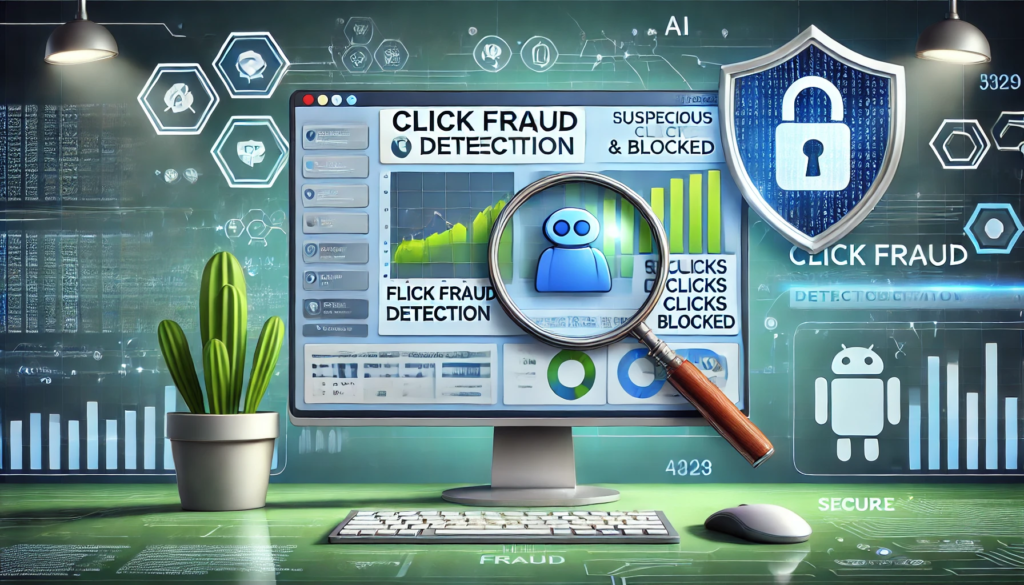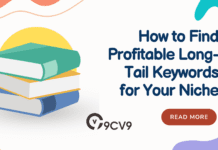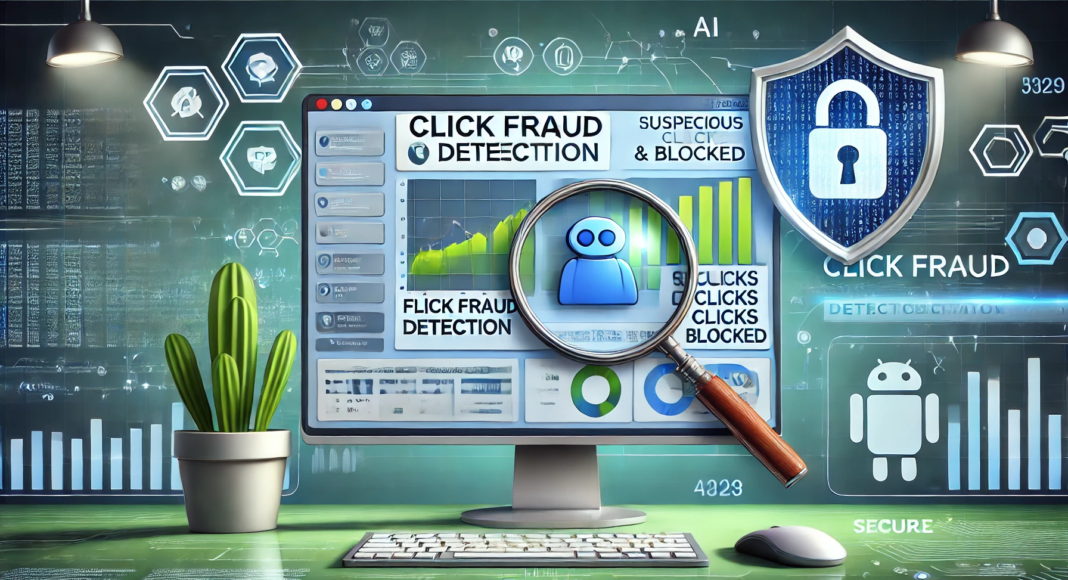Key Takeaways
- Click fraud software detects and prevents fraudulent clicks on digital ads using AI, machine learning, and behavioral analysis.
- It helps businesses protect their ad budgets, ensuring only genuine traffic engages with their pay-per-click (PPC) campaigns.
- Advanced fraud detection tools improve ROI, optimize marketing performance, and safeguard advertisers from click fraud threats.
In the fast-evolving landscape of digital advertising, businesses allocate significant budgets to online marketing campaigns to drive traffic, generate leads, and increase sales.
However, one of the most persistent threats to the effectiveness of these campaigns is click fraud—a deceptive practice that artificially inflates clicks on paid advertisements without genuine user interest.
Click fraud has become a major concern for advertisers using platforms such as Google Ads, Facebook Ads, and Bing Ads, as it leads to wasted marketing budgets, distorted analytics, and reduced return on investment (ROI).

Click fraud occurs when fraudulent clicks are generated by automated bots, click farms, or even competitors aiming to drain an advertiser’s budget.
This unethical tactic can be executed manually by individuals clicking on ads repeatedly or through sophisticated fraud networks that use advanced automation techniques.
As digital advertising continues to grow, fraudsters are becoming increasingly innovative, making it crucial for businesses to invest in solutions that can detect and prevent fraudulent activity.
To combat this growing problem, click fraud software has emerged as an essential tool for businesses and advertisers.
This advanced technology utilizes artificial intelligence (AI), machine learning algorithms, and real-time analytics to monitor ad traffic, identify fraudulent clicks, and block malicious activities before they cause significant financial losses.
By implementing click fraud software, advertisers can protect their campaigns from illegitimate clicks, ensuring that their ad spend is directed towards genuine potential customers rather than fraudulent sources.
The financial impact of click fraud is staggering.
Reports suggest that digital ad fraud, including click fraud, results in billions of dollars in annual losses for advertisers worldwide.
Fraudulent clicks not only exhaust advertising budgets but also mislead businesses into making misinformed marketing decisions based on skewed data.
Without an effective solution in place, companies risk lowering their ad quality scores, decreasing conversion rates, and ultimately failing to achieve their marketing objectives.
In this comprehensive guide, we will explore what click fraud software is, how it works, and why it is an indispensable tool for businesses running online advertising campaigns.
We will also examine its key features, benefits, limitations, and the latest trends in fraud prevention.
Understanding click fraud and the technologies used to mitigate it will help businesses safeguard their advertising investments and maximize their marketing performance.
Before we venture further into this article, we would like to share who we are and what we do.
About 9cv9
9cv9 is a business tech startup based in Singapore and Asia, with a strong presence all over the world.
With over nine years of startup and business experience, and being highly involved in connecting with thousands of companies and startups, the 9cv9 team has listed some important learning points in this overview of What is Click Fraud Software and How It Works.
If your company needs recruitment and headhunting services to hire top-quality employees, you can use 9cv9 headhunting and recruitment services to hire top talents and candidates. Find out more here, or send over an email to [email protected].
Or just post 1 free job posting here at 9cv9 Hiring Portal in under 10 minutes.
What is Click Fraud Software and How It Works
- Understanding Click Fraud
- What is Click Fraud Software?
- How Click Fraud Software Works
- Key Features of Click Fraud Software
- Benefits of Using Click Fraud Software
- Challenges and Limitations of Click Fraud Software
- How to Choose the Right Click Fraud Software
- Future Trends in Click Fraud Detection
1. Understanding Click Fraud
Click fraud is a growing concern in the digital advertising landscape, significantly affecting businesses that rely on pay-per-click (PPC) models. To combat it effectively, it’s essential to have a deep understanding of what click fraud is, how it operates, and the actors behind it.
What is Click Fraud?
Click fraud refers to the malicious practice of repeatedly clicking on a pay-per-click (PPC) advertisement with the intent to:
- Drain the advertiser’s budget without generating genuine interest or conversions.
- Increase revenue for websites running display ads by generating fraudulent clicks.
- Sabotage competitors by exhausting their ad budgets prematurely.
Example:
A competitor repeatedly clicks on a rival’s Google Ads to force them to deplete their daily advertising budget, making their ads disappear from search results.
Types of Click Fraud
Click fraud manifests in multiple forms, each with different motivations and methods of execution.
Manual Click Fraud
- Performed by individuals who intentionally click ads for malicious reasons.
- Common in highly competitive industries where rivals attempt to harm one another.
- May involve using different devices or IP addresses to avoid detection.
Example:
A small local business asks employees or friends to click on competitors’ ads during peak hours.
Automated Click Fraud (Bot Fraud)
- Uses bots or software scripts to automate clicks on PPC ads.
- Can operate at large scale and mimic human behavior to evade detection.
- Often run from data centers or infected devices in a botnet.
Example:
A fraudster deploys a botnet of thousands of compromised devices to click Google Ads, inflating traffic on a publisher’s site.
Click Farms
- Involve large groups of low-paid workers who manually click ads.
- Typically operated in developing countries where labor is inexpensive.
- Appear more “legitimate” than bots but serve no actual interest in the product or service.
Example:
A mobile app developer hires a click farm to click on in-app ads to increase ad revenue fraudulently.
Motivations Behind Click Fraud
Understanding why click fraud occurs is critical to identifying vulnerabilities.
Financial Incentives
- Publishers aim to increase revenue by clicking on ads shown on their own sites.
- Click farms are paid per click, giving them a reason to generate as many clicks as possible.
Competitive Sabotage
- Businesses may click on competitors’ ads to waste their budget and gain a competitive edge.
Revenge or Malicious Intent
- Disgruntled employees or customers may click ads as a form of digital retaliation.
Impact of Click Fraud on Businesses
Click fraud leads to multiple adverse outcomes, especially for small and medium-sized enterprises (SMEs).
Wasted Ad Spend
- Budgets get consumed by non-genuine clicks with zero ROI.
- Reduces the lifespan of campaigns, especially for those with capped daily limits.
Skewed Analytics
- Inflates impressions and click-through rates (CTR), making campaign performance metrics unreliable.
- Leads to misinformed decision-making based on distorted data.
Lower Conversion Rates
- As fraudulent clicks do not result in conversions, the conversion rate drops significantly.
- Impacts campaign optimization and quality scores in platforms like Google Ads.
Example:
A business notices a sudden spike in traffic but no corresponding increase in leads or sales, later discovering it was due to fraudulent traffic.
Who Commits Click Fraud?
Click fraud can be initiated by a range of actors, each with different motivations.
Competitors
- Engage in click fraud to drain rivals’ budgets and dominate search results.
Ad Publishers
- Click on ads hosted on their sites to boost revenue from ad networks like Google AdSense.
Bots and Botnets
- Programmed to mimic human behavior and click on ads repeatedly from various IPs.
Disgruntled Users
- Engage in fraud to retaliate against a brand or its ad campaigns.
Industries Most Affected by Click Fraud
Certain industries are more vulnerable to click fraud due to high PPC costs and competitive landscapes.
Legal Services
- Keywords in this industry can cost over $100 per click, making it a prime target.
Insurance and Finance
- High CPC and long customer acquisition cycles make fraudulent clicks extremely costly.
E-commerce
- Faces a dual threat from competitors and bad actors seeking to disrupt marketing efforts.
Example:
A legal services firm running a $500 daily budget on Google Ads discovers that 80% of its budget is depleted within the first two hours, primarily due to suspicious clicks from a single region.
How Click Fraud Can Be Detected
Early detection is critical to reducing damage.
Unusual Click Patterns
- Sudden spikes in traffic from a single location or IP range.
- High bounce rates with minimal engagement.
Repeated Clicks from the Same User
- Indicates either manual or bot-driven fraud.
Clicks Without Conversions
- High CTR but no leads or purchases is often a red flag.
Advanced Tools
- Google Ads provides some level of automatic filtering.
- Third-party click fraud detection software offers enhanced protection and reporting.
Click Fraud Statistics and Insights
- According to Juniper Research, advertisers are expected to lose over $100 billion to digital ad fraud by 2025.
- Click fraud accounts for nearly 15-20% of all PPC traffic on average.
- Industries like insurance, legal, and healthcare report the highest losses from fraudulent ad clicks.
Final Thoughts on Understanding Click Fraud
Gaining a deep understanding of click fraud is the first step toward proactive defense. By recognizing its forms, motives, actors, and consequences, businesses can better protect their ad investments and make smarter marketing decisions. Integrating advanced fraud detection systems and continuously monitoring traffic anomalies is key to staying ahead of evolving threats in the digital advertising ecosystem.
2. What is Click Fraud Software?
Click fraud software is an advanced cybersecurity tool designed to detect, prevent, and mitigate fraudulent clicks on digital advertisements. It helps advertisers, businesses, and marketers protect their pay-per-click (PPC) campaignsfrom artificial or malicious clicks that drain their ad budget, distort campaign performance metrics, and impact return on investment (ROI).
Click fraud detection tools utilize AI-driven algorithms, machine learning, and real-time analytics to identify suspicious click activity and block fraudulent sources before they cause financial harm. These tools work across multiple advertising platforms such as Google Ads, Facebook Ads, and Bing Ads, offering advertisers better control over their ad spend and overall campaign effectiveness.
How Click Fraud Software Works
Click fraud detection software operates using a combination of automated monitoring, AI-driven fraud detection, and real-time analytics to filter out fake clicks from genuine user engagement.
1. Real-Time Click Monitoring
- Tracks every click on an advertisement and records detailed behavioral data such as:
- IP address of the visitor
- Device type (mobile, tablet, desktop)
- Geolocation of the click source
- Click frequency and patterns
- Session duration and engagement behavior
- Flags any anomalies such as unusually high click rates from a single IP address or multiple clicks within a short period.
2. AI-Powered Fraud Detection
- Uses machine learning algorithms to analyze historical and real-time click data to distinguish between real users and fraudulent activity.
- Detects bot-generated traffic by identifying non-human behavior, such as:
- Instantaneous page exits
- Repetitive clicking patterns
- Unnatural browsing speeds
- AI models continuously evolve, learning from emerging fraud techniques to improve accuracy.
3. IP and Device Fingerprinting
- Click fraud software logs and tracks unique device and browser fingerprints to identify repeated offenders.
- If an IP address is flagged as fraudulent, the software blocks it from interacting with future ads.
- Helps in preventing VPN-based and proxy server fraud where attackers mask their real location.
4. Automated Blocking and Exclusions
- Once fraudulent activity is detected, click fraud software automatically blocks suspicious IP addresses and devices from interacting with ads.
- Can be integrated with Google Ads IP Exclusion Lists to ensure that fraudsters do not repeatedly click on ads.
- Reduces advertiser losses by stopping fraud at the source.
5. Geolocation Filtering
- Enables advertisers to restrict ad visibility to trusted geographical locations.
- Prevents ad clicks from countries known for high click fraud rates, such as click farms in certain regions.
- Example: A U.S.-based eCommerce business selling products only within North America can block clicks from foreign countries where legitimate purchases are unlikely.
6. Custom Fraud Detection Rules
- Allows advertisers to set custom rules and thresholds for fraud detection based on their industry and audience.
- Examples of customizable settings:
- Automatically flag clicks that exceed a set frequency from a single user.
- Block repeat clicks from non-converting users within a specific time frame.
- Restrict specific IP ranges known for fraudulent activity.
Key Features of Click Fraud Software
Different click fraud software solutions offer unique features, but most include the following essential capabilities:
1. Click Source Analysis
- Identifies whether clicks originate from real users, bots, data centers, or malicious networks.
- Provides advertisers with detailed insights into traffic quality.
2. AI-Powered Predictive Analysis
- Uses historical fraud patterns to predict and preempt future fraudulent activities.
- Enables proactive fraud prevention, reducing financial losses.
3. IP and VPN Detection
- Blocks clicks from known VPNs, proxy servers, and TOR networks often used to disguise fraudulent activity.
4. Real-Time Alerts and Reporting
- Provides live notifications when fraudulent activity is detected.
- Offers detailed reports on fraudulent click trends, blocked IP addresses, and ad performance impact.
5. Integration with Advertising Platforms
- Seamlessly integrates with Google Ads, Facebook Ads, Microsoft Ads, and other PPC platforms.
- Automates fraud blocking directly within ad accounts.
Benefits of Using Click Fraud Software
1. Protects Ad Budget and Maximizes ROI
- Prevents fraudulent clicks from depleting advertising funds, ensuring ads reach genuine users.
- Increases conversion rates by filtering out non-human traffic.
2. Enhances Campaign Accuracy and Performance
- Eliminates misleading click data, helping advertisers make informed optimizations.
- Provides accurate CTR (Click-Through Rate), CPC (Cost-Per-Click), and conversion tracking.
3. Improves Ad Targeting and Audience Reach
- Blocks non-converting fraudulent clicks, ensuring ads are displayed to real potential customers.
- Helps in refining target audience segmentation for better ad engagement.
4. Reduces Risk of Google Ads Penalties
- Google Ads penalizes accounts with suspicious traffic patterns.
- Click fraud software protects accounts from bans by ensuring compliance with ad platform policies.
5. Saves Time and Resources
- Automates fraud detection and prevention, reducing manual monitoring efforts.
- Provides detailed reports for quick decision-making.
Examples of Click Fraud Software
Several top-tier click fraud prevention tools are widely used by businesses to secure their PPC campaigns.
1. ClickCease
- Best for: Google Ads & Facebook Ads
- Features:
- AI-driven fraud detection
- Automatic blocking of fraudulent IPs
- Geolocation targeting and click source tracking
2. PPC Protect
- Best for: Large-scale advertisers and agencies
- Features:
- Advanced bot detection
- AI-powered click behavior analysis
- Integration with multiple ad networks
3. CHEQ ClickCease
- Best for: Enterprise-level fraud prevention
- Features:
- Real-time click fraud prevention
- Custom fraud detection rules
- Multi-platform support
4. Lunio
- Best for: Small to medium businesses
- Features:
- Smart AI detection
- Automated click blocking
- Performance optimization tools
5. Fraud Blocker
- Best for: Budget-friendly click fraud protection
- Features:
- IP blocking
- Device fingerprinting
- Fraudulent traffic reporting
Real-World Example of Click Fraud Software in Action
Case Study: An E-commerce Business Saves 30% of its Ad Budget
- A fashion retailer running Google Ads campaigns experienced a sudden increase in ad clicks but no conversions.
- After using ClickCease, they discovered 50% of their clicks were coming from a competitor’s automated bots.
- By blocking fraudulent IPs, they saved 30% of their ad spend and increased actual sales by 20%.
Conclusion
Click fraud software is an essential tool for businesses investing in PPC advertising. Without fraud detection mechanisms, companies risk losing significant portions of their ad budget to invalid clicks. By leveraging AI-driven fraud detection, IP blocking, and real-time analytics, businesses can maximize ad performance, protect their investments, and drive genuine conversions. As digital advertising continues to grow, investing in reliable click fraud prevention software has become a necessity rather than an option.
3. How Click Fraud Software Works
Click fraud software operates using advanced AI algorithms, real-time monitoring, and automated blocking mechanisms to identify and eliminate fraudulent clicks. By leveraging machine learning, IP tracking, and behavioral analysis, these tools safeguard advertising budgets from malicious actors, bots, and click farms.
Understanding how click fraud software works requires breaking down its key functionalities. Below is a detailed explanation of its processes, techniques, and technologies used to detect, analyze, and prevent fraudulent clicks.
1. Real-Time Click Monitoring and Tracking
Click fraud software continuously monitors all ad clicks in real time to collect detailed insights and identify fraudulent activities.
Key Monitoring Features:
- IP Address Tracking:
- Records the origin of every click and flags repeated clicks from suspicious or blocked IP addresses.
- Example: If an advertiser notices 100+ clicks from the same IP within a few minutes, the system marks it as fraudulent.
- Device and Browser Fingerprinting:
- Captures unique identifiers like device type, screen resolution, and browser version to detect recurring fraudsters using multiple accounts.
- Helps in blocking fraud from VPN users and proxy servers trying to disguise their identity.
- Click Frequency Analysis:
- Tracks the number of clicks per user and detects unusual patterns such as rapid and repeated clicks on the same ad.
- Example: A normal user might click an ad once or twice, while a bot may click 20+ times in a few minutes.
- Geolocation Tracking:
- Identifies the country, region, and city of the click source to detect fraudulent clicks from unintended regions.
- Example: A local U.S.-based business suddenly receiving high clicks from a different continent might indicate click fraud.
2. AI and Machine Learning-Based Fraud Detection
Click fraud software employs AI-powered fraud detection to differentiate between legitimate users and fraudulent clicks.
How AI Detects Fraudulent Clicks:
- Pattern Recognition:
- Analyzes past click behavior to identify irregular trends such as excessive clicks from specific regions or devices.
- Example: If a single user clicks on multiple ads across different businesses in rapid succession, AI marks it as a bot or competitor attack.
- Behavioral Analysis:
- Examines user engagement to detect fraudsters who show unnatural behavior, such as:
- Instant exits after clicking an ad (bots do not browse websites).
- Short session durations (real users tend to stay longer).
- No scrolling or interaction (fraudsters often don’t engage).
- Example: A real customer might click an ad, explore the website, and browse products, while a bot simply clicks and leaves.
- Examines user engagement to detect fraudsters who show unnatural behavior, such as:
- Predictive Analysis:
- AI learns from past fraudulent activities and proactively blocks similar patterns before they escalate.
- Helps prevent new types of fraud, even those not previously encountered.
3. IP Blocking and Exclusion Lists
Once fraudulent activity is detected, click fraud software automatically blocks suspicious IP addresses and prevents them from engaging with ads again.
How IP Blocking Works:
- Automated IP Exclusion:
- Identifies repeat offenders and adds them to the IP blocklist in advertising platforms like Google Ads, Bing Ads, and Facebook Ads.
- Prevents future fraudulent clicks from the same sources.
- Blacklisting VPNs and Proxy Servers:
- Recognizes when users are masking their IP using a VPN or proxy service and blocks them automatically.
- Example: A competitor using multiple VPNs to drain a business’s ad budget will be blocked after detection.
- Custom IP Rules:
- Allows advertisers to manually blacklist IP addresses if they notice suspicious activity.
- Example: A business may block entire IP ranges from countries where they don’t operate.
4. Fraudulent Click Source Identification
Click fraud software determines whether fraudulent clicks come from bots, click farms, competitors, or accidental clicks.
Click Fraud Sources and How They Are Detected:
- Bots and Automated Scripts:
- Software detects non-human behavior, such as:
- Clicking multiple times within milliseconds.
- Skipping the website entirely after clicking an ad.
- Example: A bot might click 1,000+ ads in an hour, which is impossible for a human.
- Software detects non-human behavior, such as:
- Click Farms (Mass Fraud Operations):
- Click fraud software analyzes patterns to detect large-scale click farms, which operate with hundreds of fake users clicking on ads.
- Example: If thousands of clicks originate from one geographical location with no conversions, it indicates a click farm attack.
- Competitor Click Fraud:
- Competitors may manually or automatically click on ads to exhaust ad budgets.
- The system flags multiple clicks from the same competitor region and blacklists them automatically.
- Accidental Clicks and Ad Placement Issues:
- Software filters out accidental clicks by identifying:
- Very short visit durations (users clicking by mistake and leaving immediately).
- Clicks from unintentional placements, such as ads appearing in inappropriate apps or websites.
- Example: A business running Google Display Ads might notice excessive clicks from gaming apps where users accidentally tap ads.
- Software filters out accidental clicks by identifying:
5. Automated Click Fraud Prevention and Blocking
Once click fraud is identified, the software takes automated actions to prevent further damage.
Fraud Prevention Techniques:
- Blocking Suspicious Traffic in Real-Time:
- Fraudulent clicks are immediately identified and blocked, preventing advertisers from wasting money on fake engagements.
- Adjusting Ad Campaigns Automatically:
- Some tools allow businesses to pause ads when fraud is detected to prevent further damage.
- Dynamic Fraud Prevention Rules:
- Advertisers can customize fraud prevention rules, such as:
- Blocking repeated clicks within a set timeframe.
- Allowing a maximum number of clicks per user per day.
- Advertisers can customize fraud prevention rules, such as:
6. Integration with Advertising Platforms
Click fraud software integrates directly with major advertising platforms for seamless fraud prevention.
Platforms Supported:
- Google Ads:
- Automatically updates Google Ads IP Exclusion Lists to block fraudulent sources.
- Facebook Ads:
- Monitors and filters fake engagements from bot accounts and fake profiles.
- Microsoft Ads (Bing Ads):
- Blocks suspicious IP addresses in Bing search campaigns.
- LinkedIn Ads, TikTok Ads, and Other Platforms:
- Some tools support multi-channel fraud prevention to ensure all paid ads remain secure.
7. Reporting and Fraud Analysis
Click fraud software provides detailed reports to help advertisers analyze fraud trends and optimize their campaigns.
Reporting Features:
- Fraud Summary Dashboard:
- Displays the number of blocked fraudulent clicks, estimated savings, and flagged IPs.
- Click Behavior Analysis Reports:
- Shows user engagement metrics to differentiate between real users and fraudsters.
- Ad Performance Impact Reports:
- Helps advertisers optimize their campaigns by understanding where fraud is occurring the most.
Conclusion
Click fraud software is an essential tool for advertisers, marketers, and businesses investing in PPC campaigns. By leveraging real-time monitoring, AI-driven fraud detection, automated IP blocking, and advanced reporting, these tools protect ad budgets, improve campaign accuracy, and ensure better ROI. Whether facing bot attacks, competitor fraud, or click farms, investing in a robust click fraud prevention solution is critical to sustaining long-term digital advertising success.
4. Key Features of Click Fraud Software
Click fraud software is designed to detect, analyze, and prevent fraudulent clicks that waste advertising budgets and distort marketing data. These tools come equipped with a variety of advanced features that leverage artificial intelligence, real-time monitoring, and automation to protect advertisers from bot clicks, competitor fraud, and click farms.
Below is a detailed breakdown of the key features of click fraud software and how they help businesses safeguard their pay-per-click (PPC) campaigns.
1. Real-Time Click Monitoring
Click fraud software continuously tracks all incoming clicks in real time to detect suspicious activity immediately.
How Real-Time Monitoring Works:
- Live Click Data Analysis:
- Every click is recorded and analyzed instantly for fraudulent patterns.
- Businesses can see who is clicking on their ads, where they are from, and how often they click.
- IP and Device Tracking:
- Captures IP addresses, device types, browser versions, and operating systems of users.
- Example: A sudden spike in clicks from multiple devices but using the same IP can indicate bot activity.
- Geolocation Tracking:
- Identifies the country, city, and region of each click source.
- Example: A U.S.-based company receiving high clicks from a region where they don’t operate may be experiencing fraud.
2. AI-Powered Fraud Detection
Artificial intelligence (AI) plays a crucial role in identifying and blocking fraudulent clicks.
AI-Based Fraud Detection Capabilities:
- Pattern Recognition:
- AI detects unusual patterns such as multiple clicks from the same user in a short period or non-human interaction behavior.
- Example: A human user might click an ad once or twice, but a bot may click hundreds of times per minute.
- Machine Learning Adaptation:
- The system continuously learns from past fraudulent behavior and updates detection rules automatically.
- Example: If a click farm tries using different IP addresses but similar browsing behavior, the AI can still detect and block them.
- User Behavior Analysis:
- Detects fraudulent engagement by analyzing bounce rates, time spent on a website, and scrolling behavior.
- Example: If a user clicks an ad but leaves in under one second, it is flagged as a fraudulent or accidental click.
3. IP Blocking and Exclusion Lists
One of the most effective ways to prevent click fraud is by blocking known fraudulent IP addresses.
How IP Blocking Works:
- Automatic IP Blacklisting:
- The system identifies repeat offenders and automatically adds them to the blocklist.
- Example: A competitor clicking on ads from their office network will be blocked permanently.
- Custom IP Exclusion:
- Advertisers can manually block specific IP addresses or entire regions.
- Example: A business that only serves local customers may block international clicks to prevent unnecessary ad spending.
- VPN and Proxy Detection:
- Identifies users masking their identity with VPNs or proxy servers and prevents them from clicking ads.
- Example: If multiple users from different countries share the same IP, the system flags it as a fraudulent VPN-based click.
4. Competitor Click Protection
Click fraud software protects businesses from competitor-driven click fraud, where rivals attempt to drain ad budgets.
How Competitor Click Protection Works:
- Repeated Click Detection:
- Tracks multiple clicks from the same IP or device over a short period.
- Example: A competing business clicking on ads every morning to exhaust a company’s budget will be blocked.
- Industry-Based Filtering:
- Recognizes competitors by identifying company-related IP addresses and excludes them automatically.
- Ad Engagement Analysis:
- Identifies users who click ads but do not engage with the website, indicating competitor fraud.
5. Click Farm and Bot Traffic Prevention
Many fraudulent clicks originate from click farms and automated bots designed to inflate click numbers artificially.
How Click Fraud Software Prevents Click Farms and Bots:
- Bot Traffic Detection:
- Uses AI to detect non-human activity, such as:
- Clicking in milliseconds.
- Not moving the mouse.
- Clicking ads from the same region at high frequencies.
- Uses AI to detect non-human activity, such as:
- CAPTCHA Verification:
- Some software automatically implements CAPTCHA challenges to verify if a user is human.
- Device and Browser Fingerprinting:
- Identifies and blocks fake users using multiple accounts on the same device.
6. Automated Fraud Prevention and Alerts
Click fraud software automatically prevents further fraudulent clicks without requiring manual intervention.
Automation Features:
- Auto-Blocking Rules:
- Advertisers can set rules like:
- Blocking users with more than 5 clicks in a minute.
- Preventing clicks from unapproved countries.
- Advertisers can set rules like:
- Real-Time Alerts and Notifications:
- Sends instant alerts when suspicious activity is detected.
- Example: If an ad campaign receives 100+ clicks from a single region in an hour, the advertiser is notified.
- Budget Protection Mechanisms:
- Some tools automatically pause ad campaigns if fraudulent activity reaches a critical level.
7. Integration with Advertising Platforms
Most click fraud software integrates directly with major PPC platforms to streamline fraud prevention.
Supported Advertising Platforms:
- Google Ads:
- Automatic updating of Google Ads IP exclusion lists.
- Facebook Ads:
- Identifies and blocks fake profile clicks and bot engagements.
- Microsoft Ads (Bing Ads):
- Detects and prevents fraudulent clicks in Bing search campaigns.
- LinkedIn Ads, TikTok Ads, and Others:
- Expands fraud protection to multi-channel marketing campaigns.
8. Advanced Analytics and Reporting
Click fraud software provides in-depth reports to help advertisers make data-driven decisions.
Key Reporting Features:
- Fraud Activity Dashboard:
- Displays real-time data on blocked clicks, fraud sources, and estimated savings.
- Click Behavior Reports:
- Shows how users interact with ads, including:
- Time spent on landing pages.
- Scrolling and engagement behavior.
- Bounce rates and conversions.
- Shows how users interact with ads, including:
- Custom Reports and Insights:
- Advertisers can generate reports based on geolocation, IPs, device types, and fraud types.
9. Multi-Layer Security for Ad Campaigns
Click fraud software adds an extra layer of security by combining multiple fraud detection techniques.
Security Enhancements:
- Cloud-Based Protection:
- Ensures 24/7 monitoring without slowing down websites.
- Data Encryption and Privacy Protection:
- Safeguards advertiser data from breaches.
- Customizable Fraud Prevention Policies:
- Businesses can set unique blocking and filtering rules based on campaign needs.
Conclusion
Click fraud software is an essential tool for protecting ad budgets, improving marketing performance, and maximizing ROI. By integrating features such as real-time monitoring, AI fraud detection, IP blocking, and competitor protection, businesses can ensure that their PPC campaigns attract only genuine, high-quality traffic.
With automated fraud prevention, integration with advertising platforms, and advanced analytics, click fraud software provides a comprehensive solution to one of the biggest challenges in digital advertising.
5. Benefits of Using Click Fraud Software
Click fraud is a significant challenge in digital advertising, leading to wasted ad spend, distorted analytics, and reduced ROI. Click fraud software helps businesses identify, prevent, and mitigate fraudulent clicks, ensuring their pay-per-click (PPC) campaigns generate real engagement and conversions.
Below are the key benefits of using click fraud software, divided into detailed sections with relevant examples.
1. Protects Advertising Budgets from Unnecessary Wastage
Click fraud can drain thousands of dollars from an advertiser’s budget by generating non-genuine clicks. Click fraud software helps businesses preserve their ad spend by eliminating fake traffic.
How It Protects Ad Budgets:
- Blocks Fake Clicks in Real-Time:
- Automatically detects bot-driven or competitor clicks and prevents them from consuming the budget.
- Example: If a competitor clicks on an ad 50 times in one hour, the software will block their IP and prevent further waste.
- IP and Device Exclusion:
- Blocks fraudulent users by identifying patterns in click behavior, location, and device information.
- Example: If an ad receives high clicks from a country where the business does not operate, the system blocks that traffic.
- Reduces PPC Campaign Costs:
- Advertisers can stretch their budget further by ensuring that only legitimate users interact with ads.
2. Improves Return on Investment (ROI) for Ad Campaigns
When fraudulent clicks are eliminated, a higher percentage of ad spend goes toward real potential customers, increasing ROI and conversion rates.
How It Enhances ROI:
- Ensures Ads Reach Genuine Users:
- Filters out fraudulent traffic, allowing real customers to engage with ads.
- Example: A retail company using Google Ads may find that, after implementing fraud protection, CTR (Click-Through Rate) remains stable but conversion rates increase due to real user engagement.
- Optimizes Customer Acquisition Costs (CAC):
- Businesses spend less per acquisition since ads are not being wasted on invalid clicks.
- Maximizes Ad Visibility for Target Audiences:
- Ensures that only relevant users see and interact with ads, improving overall campaign effectiveness.
3. Detects and Prevents Competitor Click Fraud
Competitors often click on ads to exhaust a company’s ad budget, preventing them from gaining new customers. Click fraud software identifies and blocks such activities.
How It Blocks Competitor Fraud:
- Tracks IP Addresses from Rival Businesses:
- Detects and blocks competitor clicks from their office networks or known locations.
- Example: A local law firm notices repeated ad clicks from a competing firm’s IP address and blocks them automatically.
- Analyzes Click Patterns to Identify Suspicious Behavior:
- Recognizes unusual clicking trends, such as excessive ad interactions within a short period.
- Example: If a competitor clicks an ad 10 times in 5 minutes without any engagement, they are flagged as fraudulent.
- Auto-Blocks Repeat Offenders:
- Competitor fraud is continuously monitored, ensuring they cannot repeatedly exploit ad campaigns.
4. Protects Against Click Farms and Bot Attacks
Click farms and bots generate fraudulent clicks using automated scripts or low-paid workers, creating false engagement metrics. Click fraud software prevents such illegitimate interactions.
How It Stops Click Farms and Bots:
- AI-Powered Fraud Detection:
- Uses machine learning to distinguish between human and bot behavior.
- Example: A bot clicking an ad will likely show zero scrolling, fast clicks, and an instant bounce, making it easy to detect and block.
- Blocks Suspicious Geolocations:
- Click farms often originate from specific fraud-prone regions, which can be automatically blocked.
- Implements CAPTCHA Verification:
- Some tools force suspicious users to verify their identity, reducing bot-generated fraud.
5. Enhances Campaign Performance and Data Accuracy
Fraudulent clicks distort marketing analytics, making it difficult to measure campaign success accurately. Click fraud software improves data reliability.
How It Improves Campaign Data:
- Eliminates Fake Clicks from Reports:
- Ensures CTR, bounce rates, and conversion tracking reflect real user behavior.
- Example: A company notices that their PPC campaign’s conversion rate improves after removing fraudulent traffic.
- Provides Accurate Audience Insights:
- Helps businesses understand where genuine customers are coming from, enabling better targeting.
- Optimizes Ad Spend for High-Performing Channels:
- Redirects budget from fraud-heavy channels to high-converting platforms.
6. Reduces Website Server Load and Improves Performance
High volumes of fake clicks can slow down website performance, affecting user experience and SEO rankings. Click fraud software prevents this by blocking unnecessary traffic.
How It Reduces Server Strain:
- Filters Out Non-Human Traffic:
- Prevents bot-generated requests from overwhelming the server.
- Blocks Repetitive Unproductive Visits:
- Stops fraudulent users from continuously loading web pages, improving website speed.
- Prevents High Bounce Rates from Fake Traffic:
- Ensures a better user experience for genuine visitors, enhancing SEO performance.
7. Increases Brand Protection and Reputation Management
Fake clicks can damage a brand’s online presence by skewing engagement metrics or draining budgets too quickly. Click fraud software protects brand integrity.
How It Helps Maintain Brand Reputation:
- Ensures Ads Reach the Right Audience:
- Prevents fraudulent clicks from reducing engagement quality.
- Avoids Negative SEO Impacts from Fake Traffic:
- High bounce rates from bots can harm SEO rankings, and fraud software prevents this.
- Strengthens Advertiser Trust in PPC Campaigns:
- Businesses gain confidence in their ad spending, knowing that only real users see and interact with their ads.
8. Automates Fraud Prevention and Saves Time
Manually identifying fraudulent clicks is time-consuming and inefficient. Click fraud software automates the entire process, allowing businesses to focus on other priorities.
How It Saves Time and Effort:
- Auto-Blocks Suspicious Clicks in Real-Time:
- No need for manual monitoring—fraudulent users are instantly filtered out.
- Provides Easy-to-Use Dashboards and Reports:
- Businesses can quickly review fraud analytics without technical expertise.
- Integrates Seamlessly with Advertising Platforms:
- Works with Google Ads, Facebook Ads, Microsoft Ads, and other PPC networks.
9. Customizable Fraud Protection Based on Business Needs
Different businesses face unique fraud risks, and click fraud software offers custom settings to match campaign goals.
Custom Protection Features:
- Adjustable Fraud Detection Sensitivity:
- Businesses can set click frequency limits, geolocation restrictions, and IP blacklists.
- Industry-Specific Fraud Protection:
- E-commerce, SaaS, and local service businesses can tailor fraud settings to reduce unnecessary ad spend.
Conclusion
Click fraud software is an essential tool for any business investing in PPC advertising. It provides protection against fake clicks, improves campaign performance, and ensures ad budgets are spent effectively.
By eliminating bot traffic, competitor fraud, and click farms, businesses can maximize ROI, enhance data accuracy, and achieve better marketing results. Investing in click fraud prevention is not just a cost-saving measure—it is a strategic move to ensure long-term digital advertising success.
6. Challenges and Limitations of Click Fraud Software
Click fraud software plays a crucial role in detecting and preventing fraudulent ad clicks, protecting advertisers from wasted ad spend and inaccurate campaign data. However, despite its advanced features, this technology is not without its challenges and limitations. Businesses must understand these constraints to optimize their fraud prevention strategies and ensure the best possible campaign outcomes.
Below are the key challenges and limitations of click fraud software, categorized into sub-sections for better clarity.
1. Difficulty in Distinguishing Between Genuine and Fraudulent Clicks
One of the biggest challenges of click fraud detection is accurately identifying fraudulent activity without mistakenly blocking real users.
Why It’s Difficult to Differentiate Clicks:
- Legitimate Users May Click Multiple Times
- A genuine customer may click on an ad several times before deciding to make a purchase.
- Example: A user researching a product may revisit the ad multiple times across different days, triggering false fraud alerts.
- Retargeting Ads Can Cause Repeated Clicks
- Many businesses use remarketing strategies, where users are repeatedly shown the same ad.
- Click fraud software may misinterpret repeated ad clicks as fraudulent when they are, in fact, genuine.
- Shared IPs and Public Networks Create False Positives
- People using shared Wi-Fi networks (hotels, offices, libraries) might appear as fraudulent traffic if multiple users click the same ad.
- Example: If multiple users in a corporate office click on the same ad, the software may block the entire office network.
2. Limitations in Detecting Sophisticated Click Fraud Techniques
Fraudsters constantly develop new methods to bypass detection systems, making it difficult for click fraud software to stay ahead.
Challenges in Identifying Advanced Fraud Methods:
- Human Click Farms are Hard to Detect
- Many fraudsters use real people instead of bots to generate fraudulent clicks, making detection more complex.
- Example: A competitor may hire workers from low-cost regions to manually click ads, bypassing automated bot detection.
- VPNs and Proxies Obscure Fraudulent Clicks
- Fraudsters use VPNs and proxy servers to hide their actual location, making it difficult to block malicious IPs.
- Example: A fraudster from one country could appear as a user from another by masking their IP, tricking the fraud detection system.
- Bots that Mimic Human Behavior Can Evade Detection
- Advanced bots now simulate human-like movements, such as randomized click delays, scrolling, and cursor movements.
- Example: A bot may click on an ad, navigate through the website, and even add products to a cart, making it appear legitimate.
3. Inconsistent Effectiveness Across Different Ad Platforms
Click fraud software does not function uniformly across all advertising networks, creating challenges in fraud prevention.
Limitations Across Platforms:
- Google and Facebook Have Different Fraud Detection Mechanisms
- Some platforms, like Google Ads, have built-in fraud detection, but they do not always share data with external fraud prevention tools.
- Example: A click fraud tool may flag a user as fraudulent, but Google Ads may still count the click as valid, leading to inconsistencies.
- Integration Challenges with Smaller Ad Networks
- Many lesser-known advertising platforms do not support third-party fraud prevention tools, leaving businesses vulnerable to fraud.
- Example: A business running ads on a niche advertising platform may not be able to use click fraud software effectively.
- Social Media Ads Pose Unique Click Fraud Risks
- Click fraud software is mainly optimized for search engine PPC ads, making social media ad fraud harder to detect.
4. High Cost of Implementation and Maintenance
Click fraud prevention software can be expensive, making it inaccessible to small businesses with limited advertising budgets.
Cost Challenges of Click Fraud Solutions:
- Subscription Costs Can Be High for Small Businesses
- Most fraud detection software operates on a monthly or annual subscription model, which can be costly for businesses with low ad budgets.
- Example: A small e-commerce store spending $1,000 per month on ads might struggle to justify an additional $300-$500 per month for fraud protection.
- Continuous Monitoring Requires Additional Resources
- Some businesses need dedicated personnel to review fraud reports and optimize fraud detection settings.
- Example: A marketing team may need to spend hours analyzing fraud logs to ensure legitimate traffic is not being blocked.
- Advanced Features Require Higher-Tier Plans
- More sophisticated fraud detection features, such as AI-driven fraud prevention and real-time blocking, often require premium pricing plans.
5. Potential for False Positives and Unintended Blocking
Click fraud software is not perfect and may accidentally block real customers, leading to lost sales opportunities.
Problems with False Positives:
- Legitimate Users May Be Mistaken for Fraudsters
- If a genuine customer clicks an ad too frequently, they might get flagged as fraudulent.
- Example: A loyal customer who repeatedly checks an ad for discounts or updates may be mistakenly blocked.
- IP-Based Blocking Can Affect Entire Networks
- Some businesses use office networks with shared IP addresses, meaning one false flag can block all employees from seeing the ad.
- Example: If a corporate office accidentally gets blacklisted, legitimate employees may be unable to interact with the ad.
- Lost Potential Customers Due to Aggressive Filtering
- Overly strict fraud detection settings may filter out real traffic, reducing the number of legitimate leads.
6. Dependence on Data Accuracy and Updates
Click fraud software relies heavily on accurate data and constant updates to remain effective.
Challenges Related to Data Accuracy:
- Inaccurate or Outdated Fraud Databases
- If the software does not update its fraud databases regularly, it may fail to detect newer fraud techniques.
- Example: A fraudster using a newly created bot network may bypass detection because the software hasn’t updated its database yet.
- Delayed Fraud Detection Can Still Waste Ad Spend
- Some tools only identify fraud after it has occurred, meaning businesses may still lose money before taking action.
- Example: If fraud detection reports are delayed by several hours or days, businesses may have already lost a significant portion of their budget.
- Regional Differences in Click Fraud Patterns
- Click fraud tactics vary by country and industry, requiring custom settings to optimize fraud detection.
7. Limited Legal and Regulatory Frameworks to Support Click Fraud Prevention
Click fraud remains difficult to regulate, as there are few legal consequences for fraudsters.
Legal and Compliance Challenges:
- No Universal Laws Against Click Fraud
- Many countries do not have strict regulations penalizing click fraud, allowing fraudulent actors to operate freely.
- Example: A competitor engaging in click fraud against a business may face no legal repercussions.
- Lack of Cooperation from Ad Networks
- Some advertising platforms do not fully disclose how they handle click fraud, making it difficult to hold fraudsters accountable.
- Difficulty in Pursuing Legal Action Against Click Fraudsters
- Proving intentional click fraud in a legal setting can be complex and time-consuming.
Conclusion
While click fraud software provides essential protection against fake clicks, it is not a perfect solution. Challenges such as false positives, evolving fraud tactics, high costs, and inconsistent effectiveness across platforms highlight the need for businesses to continuously monitor and optimize their fraud prevention strategies.
By understanding the limitations and addressing them strategically, businesses can enhance their PPC campaigns, protect their advertising budgets, and maximize their return on investment despite the challenges posed by click fraud.
7. How to Choose the Right Click Fraud Software
With the increasing prevalence of click fraud in digital advertising, selecting the right click fraud software is crucial for protecting ad budgets, ensuring campaign accuracy, and maximizing return on investment (ROI). However, with numerous options available, businesses must carefully evaluate several factors to make an informed decision.
This section outlines the key considerations for choosing the best click fraud detection and prevention software, divided into sub-sections for better clarity.
1. Identify Your Business Needs and Advertising Goals
Before selecting a click fraud solution, businesses must assess their specific needs, advertising platforms, and budget.
Factors to Consider:
- Ad Spend Size and Risk Exposure
- Companies with high PPC budgets (e.g., e-commerce and SaaS businesses) face a greater risk of click fraud and require robust fraud detection tools.
- Example: A business spending $50,000 per month on Google Ads will need a more advanced solution than a startup spending $500 per month.
- Advertising Platforms Used
- Some click fraud software specializes in Google Ads, while others support Facebook, Instagram, Bing, and third-party ad networks.
- Example: A company running multi-channel campaigns across Google Ads, Facebook Ads, and display networks should choose a tool with cross-platform compatibility.
- Industry-Specific Fraud Risks
- Certain industries, such as legal services, insurance, and finance, experience higher rates of click frauddue to intense competition.
- Businesses in these sectors should prioritize real-time detection and bot prevention features.
2. Check for Real-Time Click Fraud Detection and Prevention
A top-tier click fraud software should offer real-time monitoring and automatic blocking to prevent fraudulent clicks before they drain the ad budget.
Key Features to Look For:
- Live Traffic Monitoring
- Allows advertisers to see real-time activity on their ads, identifying suspicious patterns immediately.
- Example: If an IP address clicks an ad multiple times in a short period, the system should flag and block it instantly.
- Automatic Fraud Blocking
- Some tools can automatically blacklist fraudulent IPs and devices, preventing future fraudulent clicks.
- Example: A competitor repeatedly clicking on an ad from the same IP should be blocked without manual intervention.
- Behavioral Analysis and AI-Powered Detection
- Advanced tools use machine learning algorithms to detect anomalous behaviors, such as randomized click patterns, proxy usage, or bot-like interactions.
3. Ensure Compatibility with Your Advertising Platforms
Not all click fraud software integrates seamlessly with every advertising platform. Businesses must ensure the tool supports their ad networks.
Ad Platform Support Considerations:
- Google Ads and Bing Ads Integration
- Look for tools with Google Ads API integration, allowing direct fraud detection and real-time adjustments.
- Example: A software that directly syncs with Google Ads can automatically update blacklists and fraud reports.
- Facebook and Social Media Ad Protection
- Fraudulent clicks on Facebook, Instagram, and TikTok ads are harder to detect due to complex algorithms.
- Some click fraud tools specialize in social media ad fraud prevention, ensuring better audience targeting and filtering.
- Support for Third-Party Ad Networks
- Businesses running native ads, display ads, or programmatic advertising should ensure their fraud detection software supports multiple networks.
4. Look for Advanced Fraud Detection Features
Click fraud prevention software should provide comprehensive fraud detection beyond basic IP blocking.
Essential Features to Consider:
- IP and Device Fingerprinting
- Detects fraudulent users by analyzing IP addresses, browser fingerprints, and device configurations.
- Example: If the same fraudster switches VPNs but uses the same device, fingerprinting can still detect them.
- Geo-Location Tracking
- Allows businesses to track where clicks originate from and block regions with high fraud activity.
- Example: A business targeting US customers might find a surge of fraudulent clicks from non-relevant countries.
- Bot and Proxy Detection
- Identifies whether clicks are coming from automated bots, data centers, or masked proxies.
- Example: If an ad is getting clicks only from data center IPs, it’s likely being targeted by a bot network.
5. Evaluate Reporting and Analytics Capabilities
A good click fraud solution should provide detailed reports to help businesses analyze fraud patterns, ad performance, and blocked traffic.
Key Analytics Features:
- Detailed Click Reports
- Breaks down data on click timestamps, IP addresses, device types, and user behavior.
- Example: A report showing that 80% of clicks come from a single IP range could indicate a competitor’s fraudulent activity.
- Conversion Tracking and ROI Analysis
- Measures how click fraud affects ad conversions, helping businesses adjust their campaigns.
- Example: If an ad receives 100 clicks but only 2 conversions, fraud detection tools can determine if fake clicks are the cause.
- Customizable Alerts and Notifications
- Notifies advertisers when suspicious activity is detected, allowing immediate action.
6. Assess Pricing and Cost-Effectiveness
Click fraud software varies in pricing, features, and scalability, making it important to choose a solution that fits the budget.
Pricing Factors to Consider:
- Free Trials and Demo Versions
- Many providers offer trial versions, allowing businesses to test effectiveness before committing.
- Example: A company can test a 7-day trial to see how effectively the software detects fraud.
- Pricing Plans Based on Ad Spend
- Some tools charge based on monthly ad spend, while others offer flat-rate pricing.
- Example: A business spending $10,000 per month on ads should compare whether a fixed monthly fee or percentage-based pricing is more cost-effective.
- Scalability for Business Growth
- The tool should be able to scale as ad budgets increase, preventing businesses from switching software frequently.
7. Check Customer Support and Reputation
Reliable customer support and positive reviews indicate a trustworthy click fraud solution.
What to Look For:
- 24/7 Customer Support Availability
- Click fraud can happen anytime, so quick response times are essential.
- Example: If a campaign suddenly experiences a spike in fraudulent clicks, businesses need immediate support.
- User Reviews and Case Studies
- Look for real-world feedback from businesses in similar industries.
- Example: A SaaS company might prefer a tool that has been successfully used by other B2B tech companies.
- Community and Knowledge Base Resources
- A platform with FAQs, tutorials, and case studies makes it easier for businesses to maximize the tool’s effectiveness.
Conclusion
Choosing the right click fraud software is a critical step in protecting ad budgets, improving campaign accuracy, and ensuring genuine audience engagement. By evaluating real-time detection capabilities, integration support, advanced fraud detection features, analytics, pricing, and customer support, businesses can select a solution tailored to their advertising needs.
The best click fraud software should not only detect fraudulent activity but also provide proactive prevention, detailed insights, and seamless integration with advertising platforms. Businesses that invest in a robust fraud prevention strategy will benefit from higher ad efficiency, improved targeting, and better overall campaign performance.
8. Future Trends in Click Fraud Detection
As digital advertising continues to grow, click fraud is becoming more sophisticated and difficult to detect. Fraudsters are using advanced bots, AI-driven attacks, and proxy networks to manipulate advertising campaigns and drain marketing budgets. To combat these evolving threats, click fraud detection technology is advancing rapidly, incorporating AI, blockchain, predictive analytics, and other innovations.
This section explores the emerging trends in click fraud detection that will shape the future of digital advertising protection.
1. AI and Machine Learning for Advanced Fraud Detection
Artificial intelligence (AI) and machine learning (ML) are transforming how click fraud is detected, making fraud prevention smarter, faster, and more adaptive.
Key AI-Driven Advancements:
- Self-Learning Algorithms
- AI models can analyze large volumes of click data to detect patterns of fraudulent activity that traditional methods may overlook.
- Example: AI can detect subtle anomalies in user behavior, such as erratic mouse movements, click timing, and browsing patterns, which may indicate bot-driven fraud.
- Behavioral Analysis and Predictive Detection
- AI can track historical fraud trends and predict future fraudulent activities before they happen.
- Example: If a specific IP range has engaged in fraudulent clicks previously, AI can proactively flag and block similar activity.
- Real-Time Fraud Prevention
- Instead of reacting to fraud after it occurs, AI-powered tools can prevent fake clicks before they register.
- Example: Advanced fraud detection software can block traffic from known fraudsters in milliseconds, preventing wasted ad spend.
2. Blockchain Technology for Transparency and Security
Blockchain is emerging as a promising solution to enhance transparency and trust in digital advertising by verifying ad clicks in a decentralized manner.
How Blockchain Can Reduce Click Fraud:
- Immutable Transaction Records
- Each ad click can be stored in a tamper-proof blockchain ledger, ensuring that only valid clicks are counted.
- Example: Advertisers can verify that every click originates from a legitimate source, reducing fraudulent impressions.
- Decentralized Verification
- Blockchain removes the need for a centralized authority, allowing multiple trusted parties to verify clicks independently.
- Example: Ad networks, publishers, and advertisers can cross-check each click for authenticity before billing occurs.
- Smart Contracts for Ad Payments
- Payments for ads can be tied to verified engagements, ensuring that advertisers only pay for real, human-driven clicks.
- Example: If a click is detected as fraudulent, the smart contract automatically prevents payment to the publisher.
3. Increased Use of Biometric and Behavioral Authentication
To differentiate real users from bots, fraud detection systems are adopting biometric authentication and behavioral analytics.
New Fraud Prevention Techniques:
- Biometric Verification for Ad Clicks
- Some ad platforms may introduce fingerprint or facial recognition authentication for critical transactions.
- Example: High-value lead generation campaigns may require users to verify their identity before completing an action.
- Keystroke and Mouse Movement Analysis
- Fraud detection tools can analyze mouse movements, scrolling behavior, and typing speed to detect non-human activity.
- Example: If a bot clicks an ad but does not engage with the page normally, it can be instantly flagged as fraud.
- AI-Generated Human Interaction Metrics
- Click fraud detection software is evolving to analyze user intent signals, such as dwell time, engagement depth, and eye-tracking data.
- Example: If a user clicks an ad and immediately leaves, it may be an indicator of bot activity.
4. Enhanced IP and Device Fingerprinting Technology
IP blocking alone is no longer sufficient, as fraudsters are using VPNs, proxies, and rotating IPs to evade detection. Future click fraud solutions will incorporate more sophisticated device fingerprinting.
Key Innovations in Device Tracking:
- Advanced Browser and Device Fingerprinting
- Detects unique device characteristics, such as screen resolution, installed fonts, and browser plugins, to identify fraudsters.
- Example: Even if a fraudster changes their IP address, their device fingerprint remains the same, allowing accurate detection.
- AI-Based Proxy and VPN Detection
- Identifies suspicious network activity, such as frequent IP changes, mismatched geolocation, and use of datacenter IPs.
- Example: Fraud prevention tools can instantly recognize traffic coming from a VPN or Tor network.
- Cross-Device Tracking for Fraud Prevention
- Fraudsters often use multiple devices to commit click fraud, but advanced tracking can link their behavior across different platforms.
- Example: If the same fraudulent user accesses ads from different devices, the system can block their entire network.
5. Integration of Click Fraud Detection with Ad Networks and Platforms
Click fraud detection is becoming more integrated with advertising platforms, enabling seamless fraud prevention without third-party tools.
Upcoming Integration Trends:
- Built-In Fraud Detection in Google Ads and Facebook Ads
- Ad networks are improving internal fraud detection mechanisms to reduce reliance on third-party tools.
- Example: Google is investing in AI-based click verification, reducing fake clicks before they are billed.
- API-Based Fraud Prevention for Custom Ad Platforms
- Businesses running custom ad platforms will be able to integrate fraud prevention tools via APIs.
- Example: A company running a private ad exchange can implement real-time fraud detection APIs to protect advertisers.
- Automated Reporting and Refunds for Click Fraud Victims
- Future fraud detection tools may automatically request refunds for fraudulent clicks, reducing manual efforts.
- Example: If an advertiser detects 100 fraudulent clicks, the system can automatically generate a refund request to the ad network.
6. Use of Predictive Analytics for Proactive Fraud Prevention
Rather than reacting to fraud after it happens, predictive analytics will enable proactive fraud prevention.
How Predictive Analytics Will Improve Click Fraud Detection:
- Historical Data Analysis for Trend Prediction
- AI will analyze past fraudulent activity to predict which campaigns are most at risk.
- Example: If a campaign experiences an increase in fraudulent clicks during holidays, predictive analytics can flag potential threats before they occur.
- Geo-Based Fraud Risk Forecasting
- Predictive models can identify high-risk locations based on past fraud incidents.
- Example: If a surge in click fraud from a specific country is detected, advertisers can adjust targeting in real-time.
- Automated Fraud Response Systems
- Future tools will automatically adjust ad targeting, bidding, and blocking rules based on fraud predictions.
- Example: If bot activity spikes, the system can reduce ad exposure to high-risk traffic sources.
Conclusion
The future of click fraud detection is evolving rapidly, driven by AI, blockchain, predictive analytics, and biometric authentication. As fraudsters become more sophisticated, advertisers must stay ahead by leveraging advanced fraud prevention technologies.
Key trends shaping the future include:
- AI-powered fraud detection with real-time prevention
- Blockchain-based verification for ad clicks
- Advanced device fingerprinting and behavioral analysis
- Predictive analytics for proactive fraud prevention
- Seamless integration with ad networks and custom platforms
By adopting these cutting-edge fraud detection solutions, businesses can safeguard their advertising budgets, improve campaign accuracy, and maximize ROI in an increasingly competitive digital landscape.
Conclusion
Click fraud has become a major challenge in the digital advertising ecosystem, costing businesses billions of dollars annually. As fraudulent activities continue to evolve, advertisers, marketers, and businesses must take proactive measures to protect their ad campaigns, optimize their marketing spend, and ensure genuine engagement with their ads. This is where click fraud software plays a crucial role.
Click fraud software is designed to detect, prevent, and mitigate fraudulent clicks generated by bots, malicious competitors, and click farms. By leveraging advanced technologies such as AI, machine learning, real-time monitoring, IP tracking, behavioral analysis, and predictive analytics, these tools help advertisers block illegitimate traffic, safeguard ad budgets, and enhance campaign effectiveness.
Why Click Fraud Software is Essential for Modern Digital Advertising
With the increasing reliance on pay-per-click (PPC) advertising and digital marketing campaigns, businesses cannot afford to ignore the impact of fraudulent activities on their advertising investments. Click fraud software ensures that:
- Advertisers only pay for genuine clicks from real users with potential conversion intent.
- Marketing budgets are allocated efficiently, preventing wasted spend on fraudulent clicks.
- Campaign performance metrics remain accurate, enabling data-driven decision-making.
- Brands maintain a competitive edge by preventing click fraud from harming their ad rankings and ROI.
By integrating automated fraud prevention tools, businesses can reduce reliance on manual fraud detection, which is often inefficient and time-consuming.
The Future of Click Fraud Detection
As fraudulent tactics become more sophisticated, click fraud detection software will continue to evolve. The future of fraud prevention will likely include:
- AI-driven fraud detection models that adapt to new fraudulent patterns in real time.
- Blockchain technology for ad verification, ensuring transparency in click attribution.
- Advanced biometric and behavioral analytics to differentiate between human and bot activity.
- Predictive fraud prevention to identify high-risk traffic sources before damage occurs.
- Seamless integration with ad networks and platforms for built-in fraud prevention capabilities.
The continued advancements in fraud prevention technology will help businesses stay ahead of click fraud threats and ensure maximum return on advertising investments.
Final Thoughts: Why Every Advertiser Needs Click Fraud Protection
Click fraud is not just a minor inconvenience—it is a significant issue that can drain marketing budgets, skew advertising metrics, and hinder business growth. Without a proper fraud detection system, businesses are vulnerable to malicious competitors, automated bots, and fraudulent publishers seeking to exploit PPC campaigns.
By implementing robust click fraud software, advertisers can:
- Minimize financial losses due to fake clicks.
- Ensure fair competition in the digital advertising landscape.
- Gain accurate insights into customer engagement and ad performance.
- Enhance conversion rates by focusing on genuine user interactions.
Investing in click fraud protection is no longer optional—it is a necessity for businesses that want to maximize their digital advertising ROI, protect their brand reputation, and drive real customer engagement.
As the digital advertising landscape continues to expand, businesses that proactively adopt fraud detection solutions will be better positioned to thrive in an increasingly competitive market.
If you find this article useful, why not share it with your hiring manager and C-level suite friends and also leave a nice comment below?
We, at the 9cv9 Research Team, strive to bring the latest and most meaningful data, guides, and statistics to your doorstep.
To get access to top-quality guides, click over to 9cv9 Blog.
People Also Ask
What is click fraud software?
Click fraud software is a tool that detects and prevents fraudulent clicks on digital ads, helping businesses protect their advertising budgets and optimize campaign performance.
How does click fraud software work?
It uses AI, machine learning, IP tracking, and behavioral analysis to identify suspicious click activity and block fraudulent sources in real time.
Why is click fraud a problem for advertisers?
Click fraud wastes ad spend, skews campaign analytics, reduces conversion rates, and gives competitors an unfair advantage by draining marketing budgets.
Who needs click fraud software?
Businesses running PPC ads, digital marketers, e-commerce brands, and agencies using Google Ads, Facebook Ads, and other paid advertising platforms benefit from click fraud protection.
What are the main types of click fraud?
Click fraud includes competitor fraud, bot fraud, click farms, and publisher fraud, where bad actors generate fake clicks to manipulate ad performance.
Can click fraud software stop all fraudulent clicks?
While no tool is 100% foolproof, advanced click fraud software significantly reduces fraudulent activity and prevents most harmful clicks.
What technologies do click fraud software use?
Most tools leverage AI, machine learning, big data analytics, real-time monitoring, and IP filtering to detect and block fraudulent activity.
Does click fraud only happen on Google Ads?
No, click fraud occurs across various platforms, including Google Ads, Facebook Ads, LinkedIn Ads, and other PPC advertising networks.
How much does click fraud cost businesses annually?
Click fraud costs businesses billions of dollars each year by draining ad budgets, reducing campaign efficiency, and lowering conversion rates.
How can businesses detect click fraud without software?
Businesses can monitor abnormal spikes in clicks, low conversion rates, repetitive IP addresses, and unusual traffic sources as potential indicators of click fraud.
Can small businesses afford click fraud software?
Yes, many click fraud protection tools offer scalable pricing plans that cater to small businesses and startups.
How does click fraud impact PPC campaigns?
It leads to wasted ad spend, inaccurate analytics, lower ad rankings, and reduced return on investment (ROI) for advertisers.
Is click fraud illegal?
While click fraud is unethical and against advertising policies, its legality varies by jurisdiction, and some fraudulent activities can be prosecuted.
What are the signs of click fraud?
Signs include high bounce rates, excessive clicks from a single IP, repeated ad interactions without conversions, and sudden spikes in ad costs.
How do advertisers prevent click fraud?
Advertisers use click fraud software, set up IP exclusions, adjust targeting settings, and monitor analytics to minimize fraudulent clicks.
Can competitors click on my ads to waste my budget?
Yes, some competitors engage in fraudulent clicking to exhaust your PPC budget and gain a competitive advantage. Click fraud software helps prevent this.
What are click farms?
Click farms are networks of low-paid workers or automated bots that generate fake clicks on ads to manipulate engagement and deplete advertising budgets.
Does Google have built-in click fraud protection?
Google has some built-in fraud detection systems, but they are not always effective, making third-party click fraud software necessary for better protection.
How do IP tracking and blocking help prevent click fraud?
IP tracking identifies suspicious sources, and blocking prevents repeated fraudulent clicks from the same IP addresses or regions.
Can click fraud software improve ad performance?
Yes, by eliminating fake clicks, businesses get more accurate data, better audience targeting, and improved ad performance with real user engagement.
How does AI help detect click fraud?
AI analyzes user behavior, click patterns, and traffic sources in real time to identify and prevent fraudulent activity before it impacts ad campaigns.
What is behavioral analysis in click fraud detection?
Behavioral analysis tracks user engagement patterns, such as time spent on site, mouse movements, and click frequency, to distinguish real users from bots.
Can click fraud software integrate with ad platforms?
Yes, most click fraud protection tools integrate with Google Ads, Facebook Ads, and other PPC platforms to automate fraud detection and prevention.
Is bot traffic the main cause of click fraud?
Bot traffic is a significant cause, but human-based fraud, such as click farms and competitors manually clicking ads, also contributes to the problem.
How often should businesses monitor click fraud activity?
Continuous monitoring is ideal, but businesses should review click fraud reports at least weekly to adjust their strategies and prevent budget losses.
Can click fraud software reduce advertising costs?
Yes, by blocking fraudulent clicks, businesses save money, ensuring their ad budget is spent only on real potential customers.
What industries are most affected by click fraud?
E-commerce, SaaS, finance, real estate, and highly competitive industries experience the highest levels of click fraud.
Does click fraud affect organic traffic?
No, click fraud primarily affects paid traffic, but excessive bot activity may impact overall website performance and analytics.
What is the future of click fraud prevention?
Future trends include AI-driven fraud detection, blockchain-based ad verification, biometric analysis, and predictive analytics to enhance fraud prevention strategies.































![Writing A Good CV [6 Tips To Improve Your CV] 6 Tips To Improve Your CV](https://blog.9cv9.com/wp-content/uploads/2020/06/2020-06-02-2-100x70.png)


